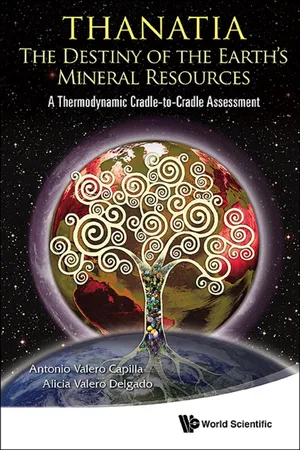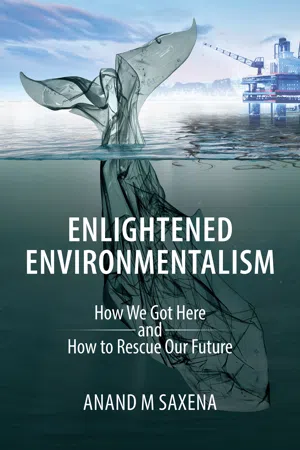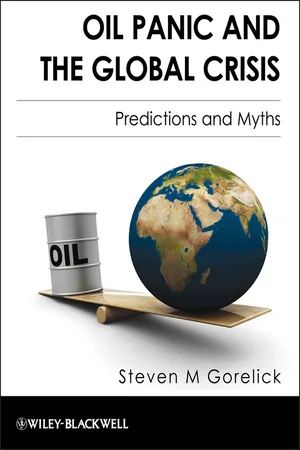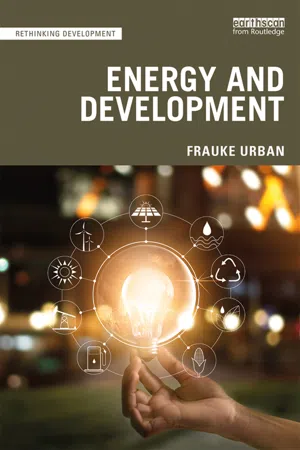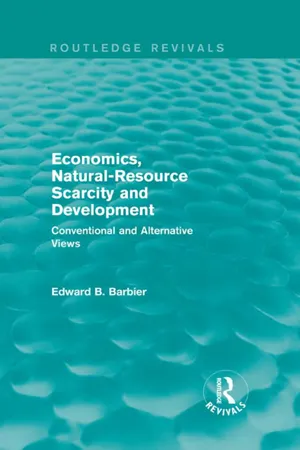Geography
Natural Resource Depletion
Natural resource depletion refers to the exhaustion or reduction of natural resources, such as water, minerals, and forests, due to human consumption and exploitation. This process can lead to environmental degradation, loss of biodiversity, and scarcity of essential resources. It is a significant concern for sustainable development and requires careful management and conservation efforts to mitigate its impact.
Written by Perlego with AI-assistance
Related key terms
Related key terms
1 of 4
Related key terms
1 of 3
7 Key excerpts on "Natural Resource Depletion"
- Avtar Singh Bimbraw(Author)
- 2021(Publication Date)
- CRC Press(Publisher)
Depletion of natural resources is associated with social inequity. Considering most biodiversity are located in developing countries, depletion of this resource could result in losses of ecosystem services for these countries. Some view this depletion as a major source of social unrest and conflicts in developing nations.At present, with it being the year of the forest, there is particular concern for rainforest regions which hold most of the Earth’s biodiversity. According to Nelson deforestation and degradation affect 8.5 per cent of the world’s forests with 30 per cent of the Earth’s surface already cropped. If we consider that 80 per cent of people rely on medicines obtained from plants and ¾ of the world’s prescription medicines have ingredients taken from plants, loss of the world’s rainforests could result in a loss of finding more potential life saving medicines.The depletion of natural resources is caused by ‘direct drivers of change, such as Mining, petroleum extraction, fishing and forestry as well as ‘indirect drivers of change’ such as demography, economy, society, politics and technology. The current practice of Agriculture is another factor causing depletion of natural resources. For example, the depletion of nutrients in the soil might be due to excessive use of nitrogen and desertification. The depletion of natural resources is a continuing concern for society. This is seen in the cited quote given by Theodore Roosevelt, a well-known conservationist and former United States president, was opposed to unregulated natural resource extraction.Natural Resources Management
Natural resources management is a discipline in the management of natural resources such as land, water, soil, plants and animals, with a particular focus on how management affects the quality of life for both present and future generations.Management of natural resources involves identifying who has the right to use the resources and who does not for defining the boundaries of the resource. The resources are managed by the users according to the rules governing of when and how the resource is used depending on local condition.- eBook - ePub
Thanatia: The Destiny Of The Earth's Mineral Resources - A Thermodynamic Cradle-to-cradle Assessment
A Thermodynamic Cradle-to-Cradle Assessment
- Antonio Valero Capilla, Alicia Valero Delgado(Authors)
- 2014(Publication Date)
- WSPC(Publisher)
All studies and reports mentioned in the previous section converge on the same ideas: monopolistic and underdeveloped markets, rapid growth in demand, an inability to outpace demand, supply shortages generally and price fluctuation. Also political and international relations tensions, regulatory barriers, uneven geological distribution and scarce resource endowment, lack of new mining investments, unsustainable mining practices and urgent research needs.For several decades ahead the world will continue to struggle with short-term scarcities. On occasions, somewhat quite dramatic ones since they can occur suddenly in a myriad of forms: from war to natural catastrophes and accidents, in addition to social, political and problems resulting from a lack of investment. Regardless of the cause, resource depletion will be definitive. As Söderholm and Tilton (2012) state “Material scarcity driven by resource depletion would occur slowly over decades, perhaps centuries. Once in place, it would likely persist for a long time and perhaps become permanent. As a result, it poses a serious potential threat to modern civilisation”.In fact, depletion of mineral resources is only seen as a problem once it becomes blindingly obvious that the availability of raw materials really is a cause for concern, by which time this realisation comes too late - rather like the unsinkable Titanic and her iceberg. Apart from the tragedy of failing to turn quick enough to avoid sea ice, humanity has also seen biological catastrophes caused by its own actions. Many species are now consigned to museum displays, glass jars, paintings, sketches and catalogues. Many more are examples of preservation, rather than conservation, in zoos. Exploitation of priceless species for Man’s whimsical fancies led to the removal of animals and plants from the face of the Earth forever. There is no reason to think that our generation will care any better for mineral resources, for a future generation’s yet to be discovered use - even should it be certain that they do have an end. It is thus a critical matter for the future sustainability of the planet and life as we live it in the Western world. - eBook - ePub
Enlightened Environmentalism
How We Got Here and How to Rescue Our Future
- Anand M Saxena(Author)
- 2021(Publication Date)
- Universal Publishers(Publisher)
fourDepletion of Planetary Resources
T here are numerous planetary resources that benefit us in many ways. Some of them are essential for our well-being while others are needed to maintain our lifestyle. Their exploitation greatly increased during the last few decades due to technological developments and the pressure of increasing population. We have been using the assets of the planet without considering its effect on sustainability, with the result that the biosphere is being degraded at a rapid rate. This trend is exacerbated by technological developments and results in a downward spiral of the depletion of nature’s endowments required for our well-being.The continuous exploitation of planetary assets is done with the implicit belief that the Earth is very large and will continue to provide for our needs forever. With this mindset, forests are razed for immediate benefits, oceans are used for dumping waste materials, and marine lives are decimated almost to the point of extinction. The immense diversity of the planetary flora and fauna that developed in the ecosystem over millennia, an important heritage of mankind, is being greatly reduced in favor of a few selected varieties that are useful at present.Although the Earth is very large, the stock of resources that we need is finite, and their continuous depletion will lead to their exhaustion with serious consequences for humanity. However, this fact runs contrary to the profit motive of major corporations whose existence depends on a continuous increase in demand from the public, which is achieved with the help of advertisements and inducements of various kinds. Almost by definition, the time scale for businesses is short and they have to show profit without considering the long-term implications of their actions. For this reason, the culture of consumption, which runs counter to the long-term survival and welfare of humanity, has been assiduously developed by businesses. - eBook - ePub
Economic Growth
International Edition
- David N. Weil(Author)
- 2016(Publication Date)
- Routledge(Publisher)
The roles of resource prices and property rights are particularly relevant when we examine how economic growth affects the environment. The key difference between a clean environment and other natural resources is that most of the time, no one owns a clean environment, so no market price is attached to creating pollution. For this reason, environmental degradation—particularly for the aspects of the environment that are least subject to property rights, such as the atmosphere—is more likely to be a problem associated with economic growth than is a shortage of natural resources.
We begin by examining the different forms of natural resources, their measurement, and their use in economic activity.NATURAL RESOURCE CONCEPTS16.1Nonrenewable Resources
A nonrenewable resource is one that exists in a fixed quantity on the earth. When a nonrenewable resource is consumed, it is gone forever. A common measure of the availability of a nonrenewable resource is the level of current reserves, or the known quantity of the resource that can profitably be extracted at current prices using existing technology. Changes in the quantity of current reserves are brought about through four processes. The first two of these are the obvious ones: discoveries of new stocks of the resource raise reserves and depletion of existing stocks lowers reserves. The third way in which reserves can change is when the price of the resource changes: for example, if the price rises, then known deposits that were previously not worth extracting can become economically viable, increasing reserves. Finally, changes in technology can also make it worthwhile to extract a resource from a known deposit, even if the resource’s price has not changed. In recent years, an important example of this effect has been the development of hydraulic fracturing (“fracking”), a technique that allows for the recovery of natural gas and oil from deep shale formations.To look in more detail at data for a nonrenewable resource, we examine the most important one in the world today: oil. In 2011, oil accounted for 33% world energy production, followed by coal (28%), natural gas (22%), renewables (11%), and nuclear (5%).1 - eBook - ePub
Oil Panic and the Global Crisis
Predictions and Myths
- Steven M. Gorelick(Author)
- 2011(Publication Date)
- Wiley-Blackwell(Publisher)
3
The Historical Resource Depletion Debate
Global oil depletion can be viewed in the context of long-standing concerns that humans have relied so heavily on Earth’s natural resources that we are surely going to run out of some essential natural commodities. There are classical historical arguments that have been used to support the notion of natural-resource exhaustion and the scientific basis for the decline in global oil production. The oil depletion debate has occurred in the context of repeated panics that the world is entering an oil-supply crisis. Has the crisis finally arrived?The Malthusian Doctrine
In 1798, Thomas Malthus, a 32-year-old British economist and demographer, published An Essay on the Principle of Population as it Affects the Future Improvement of Society . There, he argued that society as it was then known was not sustainable:… I say, that the power of population is indefinitely greater than the power in the earth to produce subsistence for man. … Population, when unchecked, increases in a geometrical ratio. Subsistence increases only in an arithmetical ratio. … I see no way by which man can escape from the weight of this law which pervades all animated nature.1Malthus concludes:Famine seems to be the last, the most dreadful resource of nature. The power of population is so superior to the power in the earth to produce subsistence for man, that premature death must in some shape or other visit the human race.2Malthus believed that population would continue to grow exponentially in a positive feedback system, with growth spawning further growth, and would outpace the world’s ability to produce food, which he thought would at best grow linearly (e.g., in proportion to the amount of cultivated arable land). Although regional famines have been devastating and continue to occur, Malthus did not foresee the technological advances in agriculture and food production that have accompanied the increasing global population. Malthus was the first apocalyptic voice for the inevitability of resource depletion, and he was wrong.3 - eBook - ePub
- Frauke Urban(Author)
- 2019(Publication Date)
- Routledge(Publisher)
11Environmental implications – Natural Resource Depletion and air pollutionNatural Resource Depletion and degradation
Fossil fuel depletion
A key environmental impact of energy use is Natural Resource Depletion. This section will address the environmental implications of fossil fuel depletion. Fossil fuel resources have been formed over millions of years from the organic remains of prehistoric animals and plants. They have a high carbon content and include coal, oil and natural gas. These fossil fuels are non-renewable energy sources, as their reserves are being depleted much faster than new ones are being formed. For example, it took millions of years to form an oil field, but it can take only a few years of exploitation to deplete it. Mining and extraction are therefore major causes of the depletion of fossil fuel resources. This leads to severe environmental impacts, including the destruction of natural ecosystems (Goldemberg & Lucon, 2009).Coal mining and oil field exploration are the most environmentally unfriendly forms of fossil fuel resource depletion. Coal mining involves the destruction and degradation of natural ecosystems and landscapes, both underground and above the ground. This means a loss of habitat for animals and plants and threats to biodiversity. Oil field exploration used to be located onshore but is now often located offshore too. Like coal mining, it involves the destruction and degradation of natural ecosystems, landscapes and habitats for animals and plants, often including sensitive marine ecosystems. Oil exploration also comes with the risk of polluting rivers, oceans, groundwater and other water bodies. This can happen, for example, when a leak occurs while drilling for oil. We will discuss these issues further when we discuss water pollution from energy sources later in this chapter.A key issue related to energy use and Natural Resource Depletion is peak oil. Peak oil is a concept that describes first an increase in oil production up to a peak and afterwards a decline in oil production. This is based on an observed rise of oil production, a peak and then a fall in the production rate of oil fields over time as the oil resources are depleted. The theory is that this phenomenon of peaking oil production not only is limited to oil fields, but also applies globally as all oil resources could be depleted at some point. This is due to rapid oil extraction from finite natural resources that can be depleted and that needed millions of years to be built. Peak oil is therefore the point of maximum oil production. There is a lively debate among scientists and the oil lobby as to whether peak oil has already happened or whether it still lies ahead. Some experts argue that we are already beyond peak oil as the rate of depletion is rapid, oil prices have increased to formerly unseen levels, few new oil resources are being found and the extraction of unconventional oil resources, such as from tar sands and shale oil, has expanded rapidly in recent years. This extraction of unconventional oil resources involves environmentally destructive methods such as fracking (Leggett, 2013). The UK Energy Research Centre published a systematic review report that reviewed over 500 studies on peak oil and global supply forecasts and concluded that a peak in oil production is likely to happen before 2030, if not earlier (UK ERC, 2009). Critics argue that new resources are being found which will add to the supply of fossil fuel resources. However, fossil fuel resources formed over millions of years, and humans are currently exploiting them within a few decades. This means that even when new fossil fuel resources are being found frequently, extraction rates are too fast to avoid depletion of these resources. - eBook - ePub
Economics, Natural-Resource Scarcity and Development (Routledge Revivals)
Conventional and Alternative Views
- Edward B Barbier(Author)
- 2013(Publication Date)
- Routledge(Publisher)
3Conventional Theory: Optimal Rates of Depletion
As a consequence of the growing concern about the increasing scarcity of fossil fuel and other raw materials, as well as the spread of the non-economic influences described in the previous chapter, conventional theories of natural-resource scarcity were extended and modified significantly after the early 1960s. In theoretical work, the emphasis has been laid on the optimal rate of depletion of exhaustible and renewable resources, with extensions to include monopoly, uncertainty and other market imperfections. The main criticism of such approaches, however, is that they are limited to a specific class of environmental problems: the increasing scarcity of economically valuable resource inputs into production. Nevertheless, they have established an important theoretical foundation for more ambitious explorations of the economic problem of environmental degradation. This chapter will survey these theories and discuss this criticism.CONVENTIONAL THEORIES OF NATURAL-RESOURCE SCARCITY
As noted in Chapter One , classical and early neo-classical economists recognized long ago that the relative scarcity of those natural resources appropriated as productive inputs is linked to their rate of use, or depletion: the earth can only supply a finite amount of available energy and raw material to the economic process. At any given time, society’s ability to exploit these resources is limited, among other things, by its technological capabilities and methods of production. On the other hand, the lack of evidence of any binding natural-resource scarcity constraint on modern economic growth has reinforced the emerging conventional economic wisdom that “there seems to be little reason to worry about the exhaustion of resources which the market already treats as economic goods”.1 For those environmental resources used as basic material and energy inputs, market forces should dictate the optimal rate of exploitation automatically and effectively.2
Index pages curate the most relevant extracts from our library of academic textbooks. They’ve been created using an in-house natural language model (NLM), each adding context and meaning to key research topics.
Explore more topic indexes
Explore more topic indexes
1 of 6
Explore more topic indexes
1 of 4

